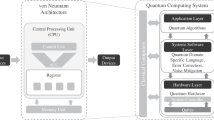Abstract
The laws ofphysics imposes limits on increases in computing power. Two of these limits are interconnect wires in multicomputers and thermodynamic limits to energy dissipation in conventional irreversible technology. Quantum computing is a new computational technology that promises to eliminate problems of latency and wiring associated with parallel computers and the rapidly approaching ultimate limits to computing power imposed by the fundamental thermodynamics. Moreover, a quantum computer will be able to exponentially improve known classical algorithms for factoring, and quadratically improve every classical algorithm for searching an unstructured list, as well as give various speed-ups in communication complexity, by exploiting unique quantum mechanical features. Finally, a quantum computer may be able to simulate quantum mechanical systems, something which seems out of the question for classical computers, thus reaching the ultimate goal of replacing actual quantum mechanical experiments with simulated ones. On the downside, for some problems quantum mechanical computers cannot significantly improve the performance of classical computers.
Partially supported by the European Union through NeuroCOLT II Working Group and the QAIP Project.The author is also affiliated with the University ofAmsterdam.
Access this chapter
Tax calculation will be finalised at checkout
Purchases are for personal use only
Preview
Unable to display preview. Download preview PDF.
Similar content being viewed by others
References
A. Ambainis, A better lower bound for quantum algorithms searching an orderedlist, Proc. 40th IEEE Symp. Foundat. Comput. Sci., 352–357,1999.
A. Ambainis, Quantum lower bounds by quantum arguments, Proc. 32nd ACM Symp. Theor. Comput., 2000.
R. Beals, H. Buhrman, R. Cleve, M. Mosca, and R. de Wolf. Quantum lower bounds by polynomials. In Proc. 39th IEEE Symp. Foundat. Comput. Sci., 1998, 352–361.
C.H. Bennett. Logical reversibility ofcomputation. IBM J. Res. Develop., 17(1973),525–532.
C.H. Bennett, F. Bessette, G. Brassard, L. Salvail and J. Smolin, Experimental quantum cryptography, J. Cryptology 5:1 (1992), 3–28; C.H.Bennett,G.Brassard and A.Ekert,Quantum cryptography,Scientific American Oct.1992, 50-57.
C.H. Bennett and P.W. Shor, Quantum information theory, IEEE Trans. Inform. Th., IT-44:6 (1998), 2724–2742.
E. Bernstein and U. Vazirani, Quantum complexity theory, SIAM J. Comput., 26:5 (1997), 1411–1473.
R. Cleve and H. Buhrman, Substituting quantum entanglement for communication, Physical Review A,56:2 (1997), 1201–1204.
M.A. Nielsen and I.L. Chuang, Quantum Computation and Quantum Information, Cambridge University Press, 2000.
H. Buhrman, R. Cleve, and A. Wigderson. Quantum vs. classical communication and computation. In Proc. 30th ACM Symp. Theor. Comput., 1998, 63–68.
L.K. Grover. A fast quantum mechanical algorithm for database search. In Proc. 28th ACM Symp. Theor. Comput., 1996, 212–219.
P.W. Shor. Polynomial-time algorithms for prime factorization and discrete logarithms on a quantum computer. SIAM Journal on Computing 26:5 (1997), 1484–1509.
P.W. Shor, Introduction to quantum algorithms, http://xxx.lanl.gov/abs/quantph/0005003
P. Benioff., J. Stat. Phys., 22 (1980), 563–591, also J. Math. Phys., 22(1981),495–507, Int. J. Theoret. Phys., 21(1982), 177-201, Phys. Rev. Letters 48(1982),1581-1585, J. Stat. Phys.,29(1982),515. 546,Phys. Rev. Letters 53(1984),1203,Ann. New York Acad. Sci.,480(1986),475-486.
D.P. DiVincenzo, T. Mor, P. W. Shor, J.A. Smolin, B.M. Terhal, Unextendible Product Bases,Uncompletable Product Bases and Bound Entanglement, http://xxx.lanl.gov/abs/quant-ph/9908070
D. Deutsch, Quantum theory,the Church-Turing principle and the universal quantum computer. Proc. Royal Society London, Series A 400 (1985), 97–117; see also Proc. Royal Society London, Series A 425(1989),73. 90;with R.Josza,Proc. Royal Society London, Series A 439(1992),553. 558.
R.P. Feynman, Simulating physics with computers, Int. J. Theoret. Physics 21 (1982), 467–488;Quantum mechanical computers.Foundations of Physics 16(1986),507. 531.(Originally published in Optics News February 1985);Tiny Computers Obeying Quantum Mechanical Laws.In:New Directions in Physics: The Los Alamos 40th Anniversary Volume, N.Metropolis and D.M.Kerr and G. Rota,Eds.,Academic ress,,Boston,1987,7. 25.
R. Landauer. Irreversibility and heat generation in the computing process. IBM J. Res. Develop., 5 (1961), 183–191.
A.K. Lenstra and H.W. Lenstra, Jr.(Eds.), The Development of the Number Field Sieve Lecture Notes in Mathematics,Vol.1554, Springer-Verlag, Berlin, 1993.
M. Li and P.M.B. Vitányi, An Introduction to Kolmogorov Complexity and Its Applications 2nd Edition, Springer-Verlag, New York, 1997.
Unruh, W.G., Maintaining coherence in quantum computers, Physical Review A 51 (1995), 992..
L.M.K. Vandersypen, M. Steffen, G. Breyta, C. S. Yannoni, R. Cleve, I. L. Chuang, Experimental realization oforder-finding with a quantum computer, http://xxx.lanl.gov/abs/quant-ph/0008065
P.M.B. Vitányi, Area penalty for sublinear signal propagation delay on chip, Proc. 26th IEEE Symp. Foundat. Comput. Sci., 1985, 197–207.
P.M.B. Vitányi, Locality,communication and interconnect length in multicomputers, SIAM J. Computing, 17 (1988), 659–672.
P.M.B. Vitányi, Quantum Kolmogorov Complexity Based on Classical Descriptions, IEEE Trans. Inform. Th., Toappear.
C. Zalka, Efficient simulations of quantum mechanical systesms by quantum computers, Proc. Royal Soc. London, Ser. A 454 (1998), 313–322.
W.H. Zurek, Decoherence and the transition from quantum to classical, Physics Today 44 (1991), 36–44.
Author information
Authors and Affiliations
Editor information
Editors and Affiliations
Rights and permissions
Copyright information
© 2001 Springer-Verlag Berlin Heidelberg
About this chapter
Cite this chapter
Vitányi, P. (2001). The Quantum Computing Challenge. In: Wilhelm, R. (eds) Informatics. Lecture Notes in Computer Science, vol 2000. Springer, Berlin, Heidelberg. https://doi.org/10.1007/3-540-44577-3_15
Download citation
DOI: https://doi.org/10.1007/3-540-44577-3_15
Published:
Publisher Name: Springer, Berlin, Heidelberg
Print ISBN: 978-3-540-41635-7
Online ISBN: 978-3-540-44577-7
eBook Packages: Springer Book Archive




